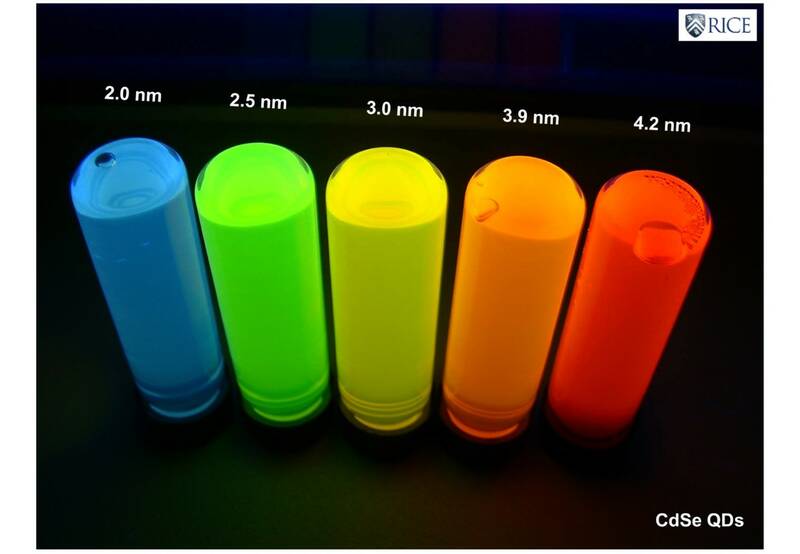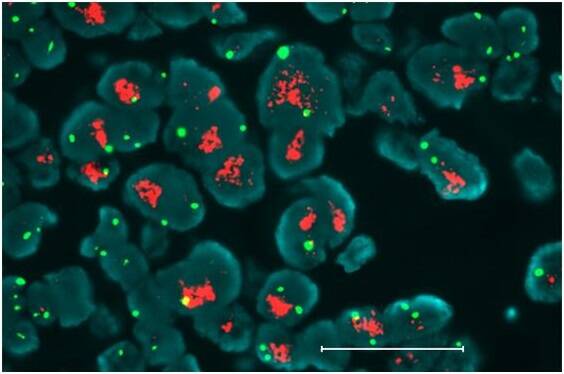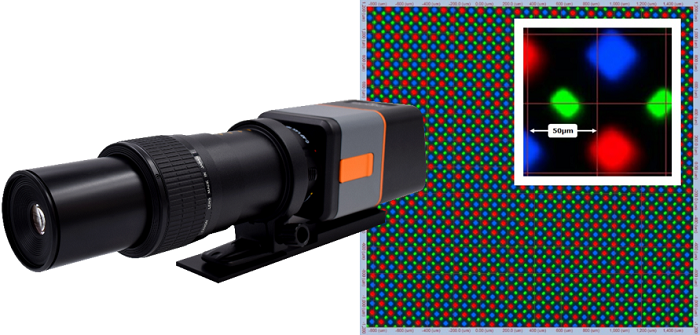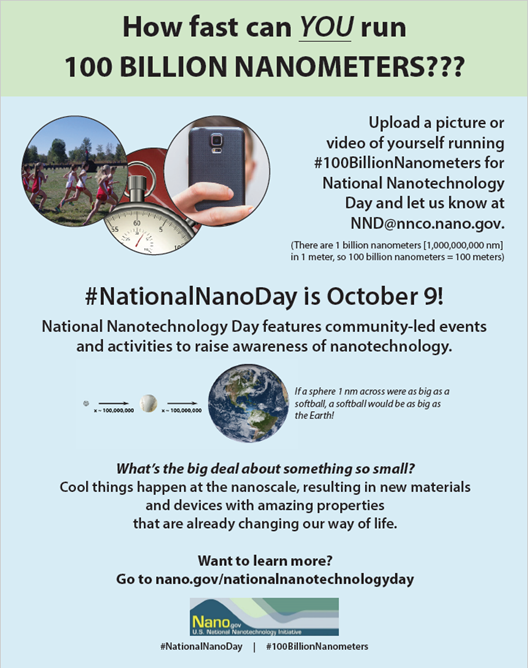Spotlight on Nanotechnology & Quantum Dots
October 9th is National Nanotechnology Day in the U.S., a date selected for its correspondence to the nanometer (nm) scale: 10-9 meters (a micrometer (µm) is 1/1000 of a meter, a nanometer is 1/1000 of a micrometer). The field of nanotechnology first emerged in the 1960s, has surged in the last two decades, and is poised to take on an increasingly significant role in the future of multiple industries.
Currently, electronics, energy, and biomedicine account for 70% of nanotechnology activity,1 but the field is having a growing impact in industries as varied as defense, cosmetics, automotive, agriculture, environmental tech, and textiles. The global market for nanotechnology is predicted to reach US$125 Billion in 2024.2
What is nanotechnology? Essentially, it is a new scientific field focused on manipulating the molecular structure of materials to change the intrinsic properties of the materials or create new materials. It describes the creation of materials and devices “with novel functions and properties based either on geometrical or on material-specific peculiarities of nanostructure.”3 For example, graphene is a modification of carbon molecules to create cylindrical sheets that are just one atom thick.
Graphene is harder than steel, stronger than a diamond, lighter than aluminum, has the highest electron mobility of any known material, and is more than 97% transparent to wavelengths of light from ultraviolet to far infrared.4 Graphene is also very flexible, a property that researchers have leveraged for the development of “electronic skin” or “smart tattoos”—graphene patches that can act as wireless sensors to monitor human pulse, breathing, hydration, and body movement.5

A graphene fitness patch monitors pulse, breathing, and hydration (Image credit: ICFO, Source).
Quantum Dot Nanotechnology
Quantum dots (QDs) are one nanotechnology that have found applications ranging from electronic displays to biomedical treatments. Essentially tiny semiconductors, quantum dots are single nanoparticles (nanocrystals) roughly 2-10 nm in diameter. Their hallmark is that they possess both optical and electrical properties.
When electrified or when exposed to light, they emit their own pure, monochromatic light. The color of the light depends on the size and shape of the particle. Larger dots emit longer wavelengths in the reddish spectrum (roughly 620-750 nm); smaller dots emit shorter wavelengths, closer to the violet end of the visible light spectrum (roughly 380-450 nm).
This “tunability” to produce different light output makes QDs useful in a wide range of fluorescent, photonic, and electrochemical applications. They are also extremely energy efficient: nearly 100% of the energy applied to a QD system is emitted as light.

Cadmium and Selenium (CdSe) quantum dots of different sizes are contained in these vials, suspended in heat-transfer fluid. The wavelength of their fluorescence is dependent on the size and shape of the QDs. (Image from Rice University Catalysis and Nanomaterials Laboratory, via Creative Commons license CC. By-SA 3.0)
Quantum dots can be made from a variety of materials such as zinc sulfide, lead sulfide, zinc selenide, cadmium selenide, or indium phosphide. For use inside the human body, they are typically coated in a protective polymer to prevent any toxins from leaching out. In the biomedical realm, their photo-physical properties are being used to help develop more “personalized” medicine approaches and to treat cancer and other diseases.
For example, QDs can be encased within a shell that is tuned to seek out and attach to disease receptors in the body. Clusters of the fluorescent particles can then be detected, giving physicians a non-invasive method to pinpoint the exact location of cancer or other harmful cells. Quantum dots can even be used to transport treatment drugs in the body. For example, they can deliver chemotherapy drugs directly to cancer cells to minimize the harmful impact on surrounding, healthy cells.6

QDs clustered around cancerous cells (red) help physicians and surgeons locate and treat the disease with precision. Scale bar = 20 µm. (Image: Source)
Quantum Dots in the Display Industry
The display industry is continually searching for technologies that can provide higher-resolution, brighter, and more vivid on-screen images. The industry has quickly adapted to QDs. A common approach is to layer a quantum dot enhancement film (QDEF) onto LED backlit screens to improve image quality. A blue LED backlight is used while the QDEF converts some of QDs to pure red and green light, which combine with the blue to create RGB pixels.
Quantum dots can be incorporated into displays in multiple ways to capitalize on their optical/visual and electronic properties. The IEEE has categorized6 some of the primary QD display types, including:
- Photo-Enhanced Quantum-Dot TV – QDs inserted between an LED array and color filters are used to purify the TV backlight, improving image color on screen. Advantages include: vivid color at high peak luminance, low cost to produce, and no burn-in (unlike OLED screens). Can be manufactured using existing LCD fabrication facilities and infrastructure.
Structure of a photo-enhanced quantum dot television (Illustration by James Provost, Source: IEEE Spectrum).
- Photo-Emissive QD TV – QDs are used as the filter layer. The blue backlight excites the dots and they become the red and green subpixels themselves; minute holes in the filter layer enable the backlight to shine through and create the blue subpixels. Advantages of this structure include: improved efficiency and brightness over traditional LCDs (as much as threefold) and a wide viewing angle. Can be manufactured using existing LCD fabrication facilities and infrastructure.
Structure of a photo-emissive quantum dot television (Illustration by James Provost, Source: IEEE Spectrum).
- Electro-Emissive QD TV – Electric current is applied to the QDs causing them to emit light directly (no backlight). Advantages of this structure include: perfect viewing angle and black levels, fast refresh rate, flexible substrates, no filter layer needed, and long lifetime. Potentially low-cost manufacturing.
Structure of an electro-emissive quantum dot television (Illustration by James Provost, Source: IEEE Spectrum).
- MicroLED TV With QDs – some microLED televisions use an array of microscopic monochrome LEDs with QDs providing the color conversion for red and green subpixels. Advantages include: perfect viewing angle, perfect blacks, no filters needed, fast refresh rate, buildable on flexible substrates, and the brightest display technology available. MicroLED displays require unique fabrication infrastructure.
Structure of a microLED quantum dot television (Illustration by James Provost, Source: IEEE Spectrum).
Multiple commercial products using QD technology are already on the market. The first was the Sony Triluminos television in 2013. Samsung’s quantum dot LED (QLED) televisions, first released in 2017, have become widespread. Samsung’s latest innovation is its Neo QLED televisions that replace the standard LED backlight panel with a miniLED backlight, which provides more precise brightness control (local dimming).
Quantum Display Quality and Performance
While they may offer superior visual performance, quantum-dot displays are still subject to the same quality issues as traditional displays. Regardless of the structure and fabrication method used, dead pixels, mura (blemishes), and non-uniformity can occur. These defects mar the viewing experience and create customer dissatisfaction if they’re not identified and corrected during production. Radiant’s visual inspection solutions measure display performance and uniformity down to the pixel and subpixel level—with precise spatial resolution as fine as 0.45 µm.
We have developed a proprietary method for measuring and correcting pixel-to-pixel variation in OLED, microLED, and similar emissive displays. Our ProMetric® Imaging Photometers and Colorimeters match the acuity and discernment of human visual perception of light and color to ensure the absolute quality of today’s ultra-high-resolution displays. When used alone or with our Microscope Lens, Radiant solutions enable QD display manufacturers to asses performance and uniformity—at production line speeds, with subpixel accuracy, and with repeatable results.

A Radiant ProMetric Y Imaging Photometer with Microscope Lens, used to measure subpixels of an OLED display.
Celebrate Nanotechnology
Join in the celebration of Nano Day on Saturday, October 9. Universities, research centers, and science organizations around the U.S. have planned nano-themed events. Some international colleagues are joining in, too. For example, European publisher Springer is sponsoring a free half-day conference with talks from leading scientists, researchers, and editors.
The U.S. National Nanotechnology Initiative suggests that we can mark the occasion by running 100 billion nanometers (100 meters). Get your stopwatch and camera ready!

CITATIONS
- Global Nanotechnology Market (by Component and Applications), Funding & Investment, Patent Analysis and 27 Companies Profile & Recent Developments – Forecast to 2024. Report published by Research and Markets, April 2018.
- Ibid.
- Yaniv, Z., “Nanotechnology and Display Applications.” Presentation of Applied Nanotech, Inc., February 2015.
- Savage, N., “Tomorrow’s industries: from OLEDs to nanomaterials.” Nature, December 11, 2019.
- Niu, S., et al., “A wireless body area sensor network based on stretchable passive tags,” Nature Electronics, No 2, pp. 360-368, August 15, 2019. doi: 10.1038/s41928-019-0286-2
- Fang, M., et al. “Quantum Dots for Cancer Research: Current Status, Remaining Issues and Future Perspectives.” Cancer Biology & Medicine 9(3): 151-163, September 2012. doi: 10.7497/j.issn.2095-3941.2012.03.001
- Luo, Z., Manders, J. and Yurek, J., “Your Guide to Television’s Quantum-Dot Future.” IEEE Spectrum, February 22, 2018.
Join Mailing List
Stay up to date on our latest products, blog content, and events.
Join our Mailing List
